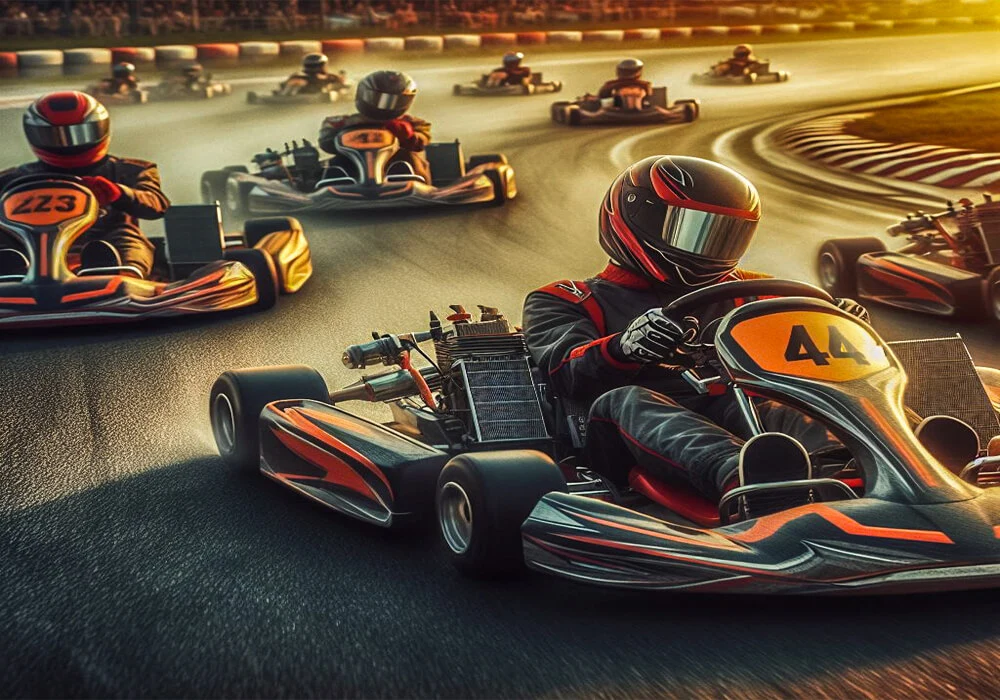Is go kart racing a sport?
Go-kart racing, often seen as a recreational activity for thrill-seekers and aspiring racers, has sparked debate over whether it qualifies as a sport.
While some view it as a mere pastime, others recognize the physical and mental demands that make it a legitimate sporting endeavor. Let’s delve into the various aspects of go-kart racing to determine if it truly deserves the title of a sport.
Definition of a Sport

Before concluding, it’s essential to understand what constitutes a sport. Typically, sports are competitive activities that require physical exertion, skill, and adherence to rules. They often involve elements of competition, strategy, and physical endurance. With these criteria in mind, let’s examine go-kart racing through this lens.
The Physical Demands of Go-Kart Racing
1. Endurance and Strength
Contrary to the perception that go-kart racing is just sitting in a small vehicle and driving around a track, it is physically demanding.
Drivers must have strong arms and shoulders to maneuver the kart, especially during long races.
The G-forces experienced during sharp turns and high-speed straights require substantial core strength to maintain control and stability.
2. Cardiovascular Fitness
Go-kart racing can significantly elevate a driver’s heart rate, akin to many other sports.
The adrenaline rush from high-speed racing, combined with the need to stay focused and responsive, makes it a cardiovascular workout.
Drivers often sweat profusely and feel physically drained after a race, similar to other athletes post-competition.
Mental Agility and Reflexes
1. Quick Reflexes and Decision-Making
Successful go-kart racers need lightning-fast reflexes to navigate the track, avoid collisions, and overtake competitors.
The need for split-second decision-making parallels other sports such as football or basketball, where players must constantly adapt to dynamic situations.
2. Concentration and Strategy
Go-kart racing requires intense concentration. Drivers must continuously monitor their surroundings, including track conditions and competitor positions.
Strategic planning is essential to decide when to overtake, defend positions, or take calculated risks, much like in chess or motorsports.
The Competitive Aspect
1. Structured Competitions
Go-kart racing isn’t just casual fun; it’s structured with leagues, championships, and various levels of competition.
From local club races to international karting championships, there are organized events where racers compete for titles and trophies.
2. Recognition and Rewards
Like any recognized sport, go-kart racing offers accolades for top performers. Winners earn trophies, sponsorships, and sometimes monetary rewards.
The existence of professional go-kart racers who transition to higher tiers of motorsport underscores its competitive nature.
Safety Regulations and Standardization
1. Strict Safety Protocols
Safety is paramount in go-kart racing, with strict regulations to protect drivers. Helmets, racing suits, gloves, and neck braces are standard equipment.
Tracks are designed with barriers and run-off areas to minimize the risk of accidents.
2. Official Rules and Governance
The sport is governed by official bodies like the Commission Internationale de Karting (CIK) under the Fédération Internationale de l’Automobile (FIA).
These organizations establish rules and standards for everything from kart specifications to race procedures, ensuring fairness and consistency across competitions.
Addressing Skepticism
1. Misconceptions About Physical Effort
Many skeptics argue that sitting in a vehicle isn’t physically demanding. However, the reality of handling a high-speed kart under intense conditions debunks this myth.
The physical exertion involved is comparable to other sports that demand both strength and endurance.
2. Viewing Go-Karting as a Stepping Stone
Another point of contention is the view of go-karting as merely a stepping stone to higher forms of motorsport, like Formula 1.
While it’s true that many professional drivers start their careers in karting, this doesn’t diminish its status as a sport. In fact, it highlights the rigorous training and skill development that go-kart racing provides.
FAQs
What makes go-kart racing a sport?
Go-kart racing qualifies as a sport because it involves physical exertion, skill, competition, and adherence to rules. Drivers must have strength, endurance, quick reflexes, and strategic thinking to succeed, meeting the criteria of a sport.
Is go-kart racing physically demanding?
Yes, go-kart racing is physically demanding. Drivers need strong arms and shoulders to maneuver the karts and core strength to handle G-forces during sharp turns. It also elevates the heart rate and can be as exhausting as many other sports.
Does go-kart racing require mental agility?
Absolutely. Go-kart racing demands intense concentration, quick reflexes, and strategic decision-making. Drivers must continuously monitor track conditions and competitors, making split-second decisions to navigate and compete effectively.
Are there organized competitions in go-kart racing?
Yes, go-kart racing has structured competitions, including local club races, national leagues, and international championships. These events provide a platform for racers to compete for titles, trophies, and recognition.
How safe is go-kart racing?
Go-kart racing is quite safe, thanks to strict safety protocols. Drivers are required to wear helmets, racing suits, gloves, and neck braces. Tracks are designed with safety barriers, and the sport is governed by organizations that establish safety standards and rules.
What role does go-kart racing play in professional motorsports?
Go-kart racing is often a stepping stone to higher tiers of motorsport, such as Formula 1. Many professional drivers begin their careers in karting, where they develop the skills and experience needed to advance to more prestigious racing series.
Conclusion
Based on the criteria of physical exertion, mental agility, competitiveness, and regulation, go-kart racing unequivocally qualifies as a sport. It demands physical strength, cardiovascular fitness, quick reflexes, strategic thinking, and adherence to strict rules and safety standards. Whether for leisure or professional pursuit, go-kart racing embodies the core elements that define a sport.
If you’re still skeptical, the best way to settle the debate is to experience go-kart racing firsthand. The thrill, challenge, and physical demands might just convince you that go-kart racing is indeed a bona fide sport. So, next time you see a go-kart track, remember that behind the fun and excitement lies a sport that demands skill, endurance, and a competitive spirit.

Jason Berry is a passionate enthusiast of all things go-karting. With years of experience in the industry, he has dedicated himself to exploring and uncovering the world of go-karts, from the adrenaline-pumping races to the intricacies of design and performance. Jason’s expertise extends beyond just the tracks; he delves into the mechanics, the technology, and the community that surrounds these thrilling machines. Through his articles and insights, Jason aims to share his knowledge and help fellow enthusiasts make informed decisions about their go-karting adventures. Whether you’re a seasoned racer or a newcomer to the sport, Jason’s expertise and passion are sure to rev up your excitement for the best go-karts on the market.

